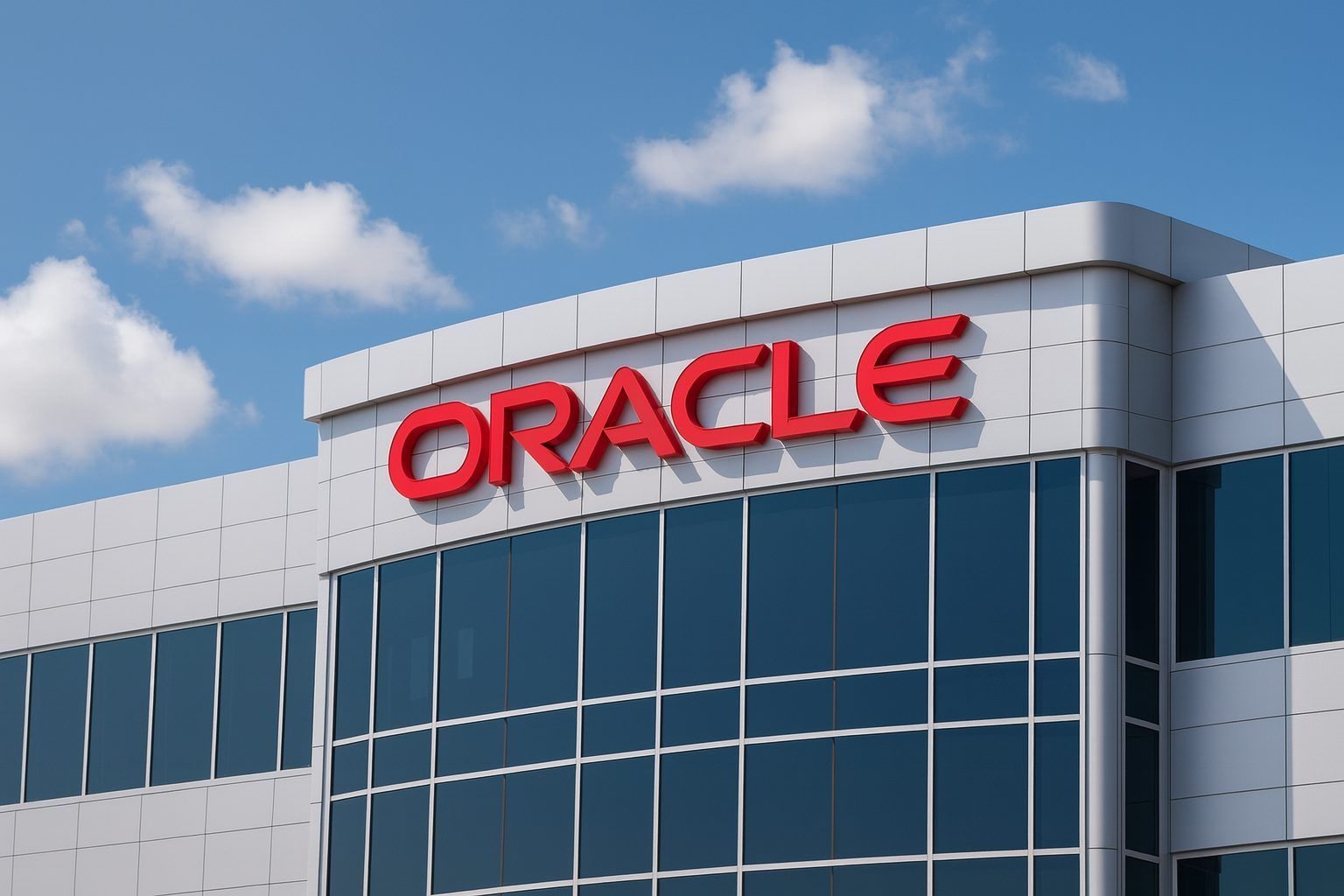Oracle Corporation’s stock remains one of the most volatile symbols in the AI trade today. On Monday, November 24, 2025, investors are digesting a fresh wave of bearish commentary on Oracle’s debt‑fuelled AI ambitions, new technical “free fall” warnings, and at the same time a major new AI Supercluster deployment in Abu Dhabi that underscores how aggressively the company is still building its cloud infrastructure. [1]
Oracle stock price snapshot for November 24, 2025
As of the latest quote on Monday, Oracle Corporation (NYSE: ORCL) is trading around $199.44 per share, modestly higher on the day, after an intraday range of roughly $194.49–$203.44 and with heavy volume.
That small bounce is happening against a brutal backdrop:
- ORCL has fallen from an early‑September all‑time high near $345.72 to about $198–$200, a drop of just over 40%. [2]
- Multiple analyses peg the two‑month decline at more than 39%, with roughly 30% lost in the last month alone. [3]
- On November 21, shares closed at $198.76, giving Oracle a market capitalization around $566 billion. [4]
Despite the sell‑off, Oracle remains a mega‑cap tech name with a modest dividend. Recent quote data show:
- Forward annual dividend: about $2.00 per share (roughly a 1% yield at current prices).
- Next earnings date: December 8, 2025, when the company reports fiscal Q2 2026 results. [5]
All the key Oracle stock news for November 24, 2025
Here’s what moved the narrative around Oracle stock today, November 24, 2025.
1. “Free fall” and bearish forecasts from technical analysts
A series of technical notes today underline how damaged ORCL’s chart looks:
- Economies.com writes that Oracle stock recently broke below a key support at $218.80, continues to trend in a “steep short‑term corrective downtrend,” and is trading under its 50‑day simple moving average, with fresh negative signals from momentum indicators. Their near‑term target is the $179.55 area and they label today’s bias “bearish.” [6]
- EBC Financial Group notes that after hitting $345.72 in early September, ORCL has fallen to roughly $198–$200, more than 40% off the peak, and now sits below all major moving averages. Their daily indicator set (RSI, MACD, ADX, moving averages) screens ORCL as a “Strong Sell,” with support zones at $192–195 and a deeper line in the sand around $180. [7]
- FXLeaders describes Oracle as being under “significant selling pressure,” having dropped below $200 after a brief surge toward $234, and warns that weakening momentum, rising costs and insider selling have eroded near‑term confidence in the stock. [8]
Taken together, today’s technical commentary paints a picture of a stock that is oversold but still in a confirmed downtrend, where any bounce is being treated with suspicion rather than enthusiasm.
2. Premarket plunge on cloud, earnings and competition worries
Early this morning, several outlets highlighted a sharp move lower in pre‑market trading:
- A pair of notes from AInvest report that Oracle shares fell about 5.66% in pre‑market trading on November 24, one of the steepest single‑session moves in recent history for the company. The drop is pinned on skepticism over Oracle’s cloud growth trajectory, mixed earnings guidance, and intensifying competition from Amazon Web Services, Microsoft Azure and Snowflake. [9]
Those concerns build on the reaction to Oracle’s fiscal Q1 2026 results, where the company delivered:
- Revenue of about $14.93 billion vs. roughly $15.04 billion expected, still up 12% year‑on‑year. [10]
- Solid double‑digit growth in cloud revenue but not enough acceleration to satisfy investors who had bid the stock up on AI excitement.
The message in today’s premarket commentary: “Good” isn’t good enough when a stock has been priced for perfection.
3. New deep‑dive explains the 39–40% two‑month slide
A widely cited breakdown today from Finviz/Insider Monkey summarises why Oracle’s stock has unwound so violently over the last two months: [11]
- ORCL has fallen more than 39% in two months, largely on fears of a growing AI bubble.
- Analysts at Robert W. Baird and Jefferies have reiterated Buy ratings but cut price targets (for example, from $365 to $315 and a separate target at $400), signalling that even bulls think the prior valuation was stretched.
- The article points to September’s leadership shake‑up—with long‑time CEO Safra Catz moving to Executive Vice Chair and Clay Magouyrk and Mike Sicilia stepping in as co‑CEOs—as a psychological turning point, especially when followed by a wave of AI‑linked debt issuance and rising worries about the sustainability of Oracle’s backlog.
The same piece highlights that Oracle has raised around $18 billion in new bonds, pushing total debt above $100 billion, while the price of five‑year credit‑default swaps on Oracle has roughly tripled, reflecting a higher perceived credit risk even though the company still holds an investment‑grade rating. [12]
4. Abu Dhabi Supercluster: Oracle doubles down on sovereign AI
Balancing the negative sentiment, Oracle announced a major infrastructure milestone today that illustrates why the company has become so central to the AI debate:
- In the Oracle Cloud Abu Dhabi Region, Oracle has deployed the first Oracle Cloud Infrastructure (OCI) Supercluster powered by NVIDIA Blackwell GPUs in the Middle East, a system equipped with more than 4,000 Nvidia Blackwell GPUs. [13]
- The Supercluster is designed to support sovereign AI initiatives across the region, helping governments and enterprises in sectors like smart government, energy, finance, healthcare, logistics, aviation and telecoms train and deploy large AI models while keeping data within local borders. [14]
- Oracle is pitching this as a building block toward Abu Dhabi’s ambition to become the world’s first fully AI‑native government by 2027, underscoring the strategic role of OCI in national‑scale AI deployments. [15]
For investors, this is a double‑edged sword: the Abu Dhabi Supercluster reinforces Oracle’s position in high‑end AI infrastructure, but it also adds to the capital‑intensive build‑out that is worrying bond markets and some equity holders.
5. Institutional buying vs. heavy insider selling
A new MarketBeat report today shows that not all big money is running away from ORCL: [16]
- Summit Global Investments opened a new position of 50,065 Oracle shares, worth roughly $10.95 million in Q2. Oracle now accounts for about 0.6% of Summit’s portfolio and is its 25th‑largest holding.
- The article also notes that other institutional investors have been adding to their stakes, with institutional and hedge‑fund ownership sitting around 42–43% of outstanding shares.
However, the same filing data reveal aggressive insider selling in recent months:
- CEO Clayton (Clay) Magouyrk sold around 40,000 shares (roughly $11 million) and director Jeffrey Berg sold about 49,365 shares (roughly $14 million).
- In total, company insiders disposed of about 204,254 shares worth more than $60 million over the last 90 days, although insiders still control roughly 40.9% of the stock. [17]
In the context of a leadership reshuffle and a sharp share‑price correction, that insider activity is feeding the narrative that Oracle’s own executives may see the near‑term risk/reward as less attractive, even as some institutions treat the slide as a buying opportunity.
6. AI debt wave and credit‑market worries
Beyond the equity market, Oracle has become a symbol of AI‑driven leverage risk:
- A detailed analysis from The Register notes that Oracle’s capital spending is expected to jump to about $35 billion in fiscal 2026, up from $21 billion in fiscal 2025, largely to fund AI‑focused data centres. [18]
- The same article highlights that Oracle has already issued $18 billion in bonds and could ultimately borrow around $100 billion over the next four years to support gigantic AI cloud campuses and a reported $300 billion compute contract with OpenAI. [19]
- Traders have piled into Oracle’s credit‑default swaps: the cost of insuring $10 million of Oracle debt for five years has roughly tripled, and more than $5 billion of Oracle CDS has changed hands since September, versus about $200 million in the same period last year. [20]
Separate coverage in the financial press frames Oracle as part of a broader “AI debt wave” that could reshape credit markets, as multiple mega‑cap tech companies borrow heavily to fund AI infrastructure. [21]
A new Forbes/Trefis piece today, “Why Is Oracle Stock Dropping?”, ties the roughly 30% one‑month decline directly to worries about these aggressive capital investments and mounting debt, arguing that Oracle is following a familiar boom‑and‑bust pattern where future‑oriented AI stories collide with near‑term financial reality. [22]
7. Balanced voices still emphasize Oracle’s cloud and AI strength
Not all commentary is negative.
Despite the recent drawdown, Oracle’s underlying business metrics remain strong:
- For fiscal 2025, Oracle reported total revenue of $57.4 billion, up 8% in U.S. dollars, with cloud services and license support revenue up 12% to $44 billion. [23]
- In Q1 fiscal 2026, total revenue climbed 12% year‑on‑year to $14.93 billion, driven by cloud revenue of $7.19 billion, up 28%, even as legacy software revenue declined slightly. [24]
- Oracle’s investor materials and recent commentary from Larry Ellison highlight explosive growth in “multi‑cloud” database revenue, which grew 115% from Q3 to Q4 FY25, and Oracle Cloud Infrastructure (OCI) consumption revenue growing 62% in the same quarter. [25]
Other pieces today, such as Insider Monkey’s “Here’s What Drives Oracle’s (ORCL) Strong Performance” and Zacks’ comparison of Salesforce vs. Oracle, stress that Oracle’s cloud and AI revenue growth is still outpacing some competitors, even if the stock has overshot on the way up and is now overshooting on the way down. [26]
Fundamentals check: Is Oracle’s business breaking, or just its multiple?
Looking through the noise, today’s data points reinforce a key idea: Oracle’s business is not collapsing, but its valuation and capital structure are being aggressively repriced.
What still looks strong:
- Double‑digit revenue growth (12% YoY last quarter) with cloud revenue up 28% and now almost half of total sales. [27]
- A huge remaining performance obligation (RPO) backlog of roughly $455 billion, mostly tied to cloud infrastructure commitments, highlighted when Q1 FY26 results were released. [28]
- Durable, high‑margin software and support businesses that continue to throw off billions in operating income and fund dividends. [29]
What is making investors nervous:
- Operating expenses rose about 14% year‑on‑year in Q1 FY26, outpacing revenue growth, as AI infrastructure, R&D and restructuring costs climbed. [30]
- Interest expense is up around 10% as Oracle takes on more debt, which, combined with higher tax expense, has left net income largely flat despite revenue growth. [31]
- Oracle’s net debt now exceeds twice its EBITDA, and some forecasts expect that leverage ratio to double again by 2030 if the AI build‑out continues at current pace. [32]
The core tension for the market is simple: Can Oracle turn its massive AI and cloud commitments into cash flow fast enough to justify the leverage and the prior premium valuation?
Technical picture: Levels to watch after a 40% reset
From a chart and sentiment perspective, today’s commentary points to a market still pricing in more risk than reward in the near term.
Key technical takeaways from EBC, Economies.com and FXLeaders: [33]
- ORCL is trading well below its 20‑, 50‑, 100‑ and 200‑day moving averages, with most trend indicators flashing “Sell” or “Strong Sell.”
- RSI sits just above oversold territory, suggesting the stock is beaten‑up but not yet showing a convincing reversal signal.
- Short‑term support is clustered in the $192–195 zone, with a deeper target around $180 if selling resumes.
- On the upside, $213–215 and then $218–220 are key resistance bands where broken support and short‑term moving averages now hang overhead.
In practical terms, the technicals say that bounces are likely to be sold unless Oracle delivers a catalyst strong enough to change the story around AI profitability and balance‑sheet risk.
What today’s news means for different types of investors
Long‑term, fundamentals‑driven investors
If you own or are considering Oracle as a multi‑year AI and cloud platform investment:
- Today’s news reinforces that demand for high‑end AI infrastructure is real—Abu Dhabi’s Supercluster is a major, concrete deployment, not just a press‑release concept. [34]
- At the same time, the scale and speed of the build‑out mean Oracle is absorbing substantial execution, credit and macro risk. If AI spending slows or key partners like OpenAI under‑deliver on usage, Oracle will still be stuck with the datacenters and the debt. [35]
From a long‑term perspective, the 40% pullback de‑risks the valuation but not the business strategy. The stock may appeal to investors who:
- Believe large‑scale AI cloud will remain structurally in demand,
- Are comfortable with a leveraged, capital‑intensive infrastructure story, and
- Can tolerate high volatility over the next several years.
Active traders and short‑term speculators
For traders, ORCL is currently a high‑beta, news‑driven name:
- Today’s combination of bearish technical calls, premarket volatility and ongoing negative headlines around AI debt make it a prime candidate for fast swings in both directions. [36]
- Short‑term setups are likely to focus on whether ORCL can hold the $192–195 support area and reclaim the $200–213 band, or whether momentum breaks down toward the $180 region flagged by several technical analysts. [37]
Risk control is critical here: the recent range and ATR numbers imply wide daily moves, which can punish tight stops and oversized positions. [38]
Income‑oriented investors
Oracle’s ~1% dividend yield is not the primary attraction; it’s more of a sweetener on top of the growth story. [39]
For dividend‑focused investors, the main questions after today’s news are:
- Will Oracle prioritize debt reduction and datacenter capex over future dividend increases?
- Could rising interest expense and macro stress eventually put pressure on capital returns?
Right now, there is no sign of an imminent dividend cut, and Oracle still generates substantial cash. But the direction of travel in leverage and interest costs means income investors need to watch future guidance and cash‑flow statements carefully. [40]
Upcoming catalysts to watch
Looking beyond today:
- December 8, 2025 – Fiscal Q2 2026 earnings:
This is the big near‑term event. Markets will focus on:- Cloud and AI revenue growth vs. expectations,
- Updated commentary on the AI backlog and OpenAI deal,
- How capex and debt projections evolve,
- Any reassurances around profitability and cash flow. [41]
- Macro and sector‑wide AI sentiment:
Articles over the last week show that Oracle is trading as a proxy for AI exuberance and AI fatigue. Shifts in rates expectations, credit markets, or sentiment toward AI capex at peers (Nvidia, Microsoft, Alphabet, Amazon) will likely spill directly into ORCL’s price. [42] - Further AI infrastructure announcements:
Any new Supercluster projects, sovereign‑cloud wins or updates on mega‑campus build‑outs (such as the mooted “Stargate” data campus) will move the narrative in either direction, depending on how clearly Oracle ties them to profitable demand rather than just capacity building. [43]
Bottom line: Oracle stock today
On November 24, 2025, Oracle stock sits at the crossroads of massive AI opportunity and very real financial risk:
- The bear case, amplified by today’s notes, is that Oracle has become over‑levered to an AI bubble, with aggressive spending, rising debt costs, credit‑market unease and a damaged technical profile. [44]
- The bull case is that Oracle remains a fundamentally strong, fast‑growing cloud and AI platform with a huge backlog, unique sovereign‑cloud capabilities (as showcased in Abu Dhabi), and the potential to translate today’s AI investments into tomorrow’s cash flows. [45]
For now, markets are clearly in “show me” mode: the stock has repriced by over 40% in two months, and investors will demand hard evidence—starting with December’s earnings—that Oracle can turn AI promises into sustainable profit without over‑stretching its balance sheet.
This article is for information and education only and does not constitute financial advice, investment recommendation or an offer to buy or sell any security. Always do your own research and consider speaking with a licensed financial advisor before making investment decisions.
References
1. www.economies.com, 2. www.ebc.com, 3. finviz.com, 4. finviz.com, 5. finance.yahoo.com, 6. www.economies.com, 7. www.ebc.com, 8. www.fxleaders.com, 9. www.ainvest.com, 10. www.ebc.com, 11. finviz.com, 12. finviz.com, 13. www.intelligentcio.com, 14. www.intelligentcio.com, 15. www.intelligentcio.com, 16. www.marketbeat.com, 17. www.marketbeat.com, 18. www.theregister.com, 19. www.theregister.com, 20. www.theregister.com, 21. finviz.com, 22. www.forbes.com, 23. investor.oracle.com, 24. investor.oracle.com, 25. www.oracle.com, 26. www.insidermonkey.com, 27. investor.oracle.com, 28. www.theregister.com, 29. www.oracle.com, 30. investor.oracle.com, 31. investor.oracle.com, 32. www.theregister.com, 33. www.economies.com, 34. www.intelligentcio.com, 35. www.theregister.com, 36. www.economies.com, 37. www.ebc.com, 38. www.ebc.com, 39. finance.yahoo.com, 40. investor.oracle.com, 41. finance.yahoo.com, 42. www.investopedia.com, 43. www.theregister.com, 44. www.economies.com, 45. www.intelligentcio.com







